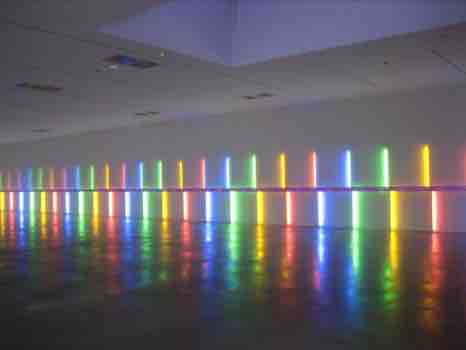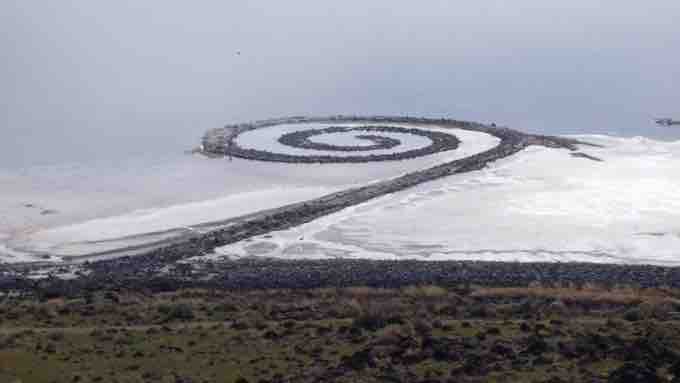Site-specific art is artwork created to exist in a certain place. Typically the artist takes the location into account while planning and creating the artwork. The actual term was promoted and refined by Californian artist Robert Irwin, but it was actually first used in the mid-1970s by young sculptors, such as Patricia Johanson, Dennis Oppenheim, and Athena Tacha, who had started executing public commissions for large urban sites. Architectural critic Catherine Howett and art critic Lucy Lippard were among the first to describe site-specific environmental art as a movement.

Site-specific installation by Dan Flavin, 1996, Menil Collection.
This site-specific installation by Dan Flavin is uses different colored lights to illuminate this interior gallery space.
Background
Site-specific art emerged as a reaction to the proliferation of Modernist art objects as transportable, nomadic, museum oriented, objects of the market and commodification, with the desire to draw attention to the site and the context that surrounded it. Site-specific work can refer to any form of art as long as it has been created for a specific environment or space. Closely related to Land Art and Environmental Art movements, site specific art is the more broad of the three as it is not medium-specific.
Land Art and Earth Art
Land art, earthworks (coined by Robert Smithson), or Earth art is an art movement in which landscape and the work of art are inextricably linked, so in this way it is site specific. It is also an art form that is created in nature, using natural materials such as soil, rock (bed rock, boulders, stones), organic media (logs, branches, leaves), and water with introduced materials such as concrete, metal, asphalt, or mineral pigments. Sculptures are not placed in the landscape, rather, the landscape is the means of their creation. Often earth moving equipment is involved. The works frequently exist in the open, located well away from civilization, left to change and erode under natural conditions. Many of the first works, created in the deserts of Nevada, New Mexico, Utah or Arizona were ephemeral in nature and now only exist as video recordings or photographic documents.
Robert Smithson (January 2, 1938 – July 20, 1973) was an American Land artist. His most famous work is Spiral Jetty (1970), a 1,500-foot long spiral-shaped jetty extending into the Great Salt Lake in Utah constructed from rocks, earth, and salt. It was entirely submerged by rising lake waters for several years, but has since re-emerged.

Robert Smithson, Spiral Jetty
Spiral Jetty is a site specific piece of Land Art or Earth Art created by Robert Smithson in the Great Salt Lake, Utah. Using rocks and earth, Smithson built up a spiral shaped relief in the lake bed. Best viewed from above, the piece is altered by the shifting waters over time and in this way is forever linked to the environment it was intended for.
Christo Vladimirov Javacheff and Jeanne-Claude, known as Christo and Jeanne-Claude, are a married couple who created site-specific environmental works of art. Their works nearly always entail wrapping a large area of space or piece of architecture in a textile, and include the wrapping of the Reichstag in Berlin and the Pont-Neuf bridge in Paris, the 24-mile (39 km)-long artwork called Running Fence in Sonoma and Marin counties in California, and The Gates in New York City's Central Park. The purpose of their art, they contend, is simply to create works of art for joy and beauty and to create new ways of seeing familiar landscapes.
Christo and Jeanne-Claude, Pont Neuf, 1985
The artists Christo and Jeanne-Claude are known for their site-specific works that make use of large scale wrapping techniques. In this piece, they wrapped an entire stone bridge built over a river in Paris to mesmerizing effect.